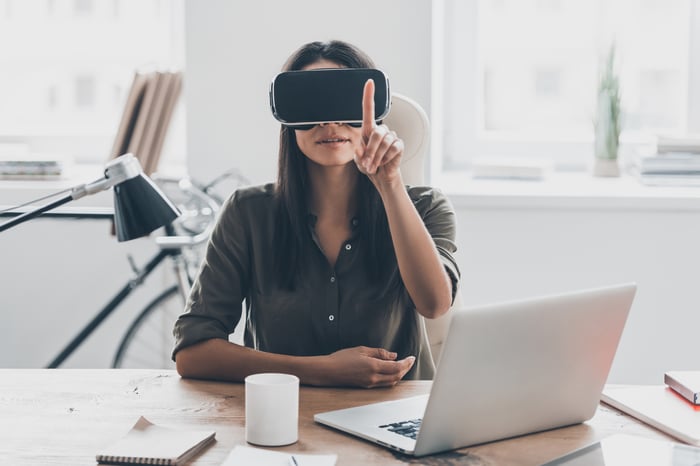The virtual reality (VR) market, which is estimated to reach up to $45 billion for gaming alone by 2025, shows early potential for mainstream use, but there are limitations to using the technology that need to be overcome in order for VR to reach mass adoption. We'll review these limitations, but first let's look at one VR product that is being rapidly adopted, and what the device's success says about the broader market for the technology.
Cardboard is where it's at
One big success in the VR space has been Alphabet's (GOOG 1.25%) (GOOGL 1.27%) Google Cardboard. Yes, it's a virtual reality device actually made out of cardboard, which means it's relatively cheap costing only $15. More advanced VR devices like Facebook's (META 2.98%) Oculus Rift and Sony's (SONY 0.31%) Playstation VR cost hundreds of dollars. Alphabet's Cardboard is cheap not only because its made out of cardboard but because its also designed to be good at simple things like viewing photos and videos. Recently, Alphabet announced it has shipped over 10 million Cardboard viewers since the product launched in 2014. There were as many Cardboards shipped in 2016 as the first two years, which shows accelerating adoption.

Google Cardboard. IMAGE SOURCE: ALPHABET INC.
The success of Google Cardboard is proof that there is interest in VR. Cardboard users have downloaded 160 million Cardboard apps on Google Play, demonstrating that people enjoy using it for the simple tasks it was designed for.
Unfortunately for all it's doing to get people using VR technology, Cardboard also highlights what is wrong with higher end VR headsets.
Virtual reality is too expensive
More expensive, high-tech VR headsets from Facebook, HTC (HTCKF 75.68%), and Sony haven't been as successful, having shipped only hundreds of thousands of units in 2016. Samsung's (NASDAQOTH: SSNLF) Gear VR shipped 4.5 million units in 2016, which stands out from the much lower totals of Sony's Playstation VR, Facebook's Oculus Rift, and the HTC Vive. But Samsung Gear VR retails for $130, a fraction of the cost of the other headsets.
Obviously, price is a key factor in people's decision to buy one of these devices. The cheap build and low price of Alphabet's Cardboard highlights another feature working in its favor -- simplicity. Cardboard is just a little rectangular box you hold up to your eyes. There are no wires, it's not a clunky thing you strap around your head. Cardboard is as simple to use as taking pictures with a smartphone.
Virtual reality is hyped for good reason
VR won't take off as a mainstream technology until more advanced VR headsets get cheaper and simpler in design. One of the other key differences between Cardboard and the more advanced VR systems is that Cardboard only requires a smartphone to use. Some advanced VR headsets for gaming and other graphically intense applications require a high-end gaming PC to operate properly, which adds to the expense of using VR.
VR headsets made for consoles, on the other hand, such as Sony's Playstation VR, may have an advantage over headsets made to work with PCs, since consoles are cheaper and are dedicated to gaming, not to mention that Playstation VR is already priced about 30% less than the $600 Oculus Rift.

Virtual reality has big growth opportunities for areas besides gaming. IMAGE SOURCE: GETTY IMAGES.
The technology has been hyped for good reason. The hype reflects people's excitement for the technology to revolutionize areas not just in gaming, but in content and education as well. One example I find interesting of how VR is being used for educational purposes is through an app called Lithodomos VR, which allows the user to see what the ancient city of Jerusalem looked like 2000 years ago. This kind of application of VR technology, along with the medical treatment possibilities for things like attention deficit hyperactivity disorder, is what gives VR the potential to be a widely adopted, common appliance used by millions of people.
Virtual reality needs to be affordable and simple
Companies developing VR technology would do best not to rush anything, to be patient in getting a product to market, and take advantage of using cheaper versions of VR technology like Alphabet's Cardboard or Samsung's Gear VR as a way to introduce the masses to the new technology to ensure everyone who uses it has a good experience, and doesn't drain your bank account.





